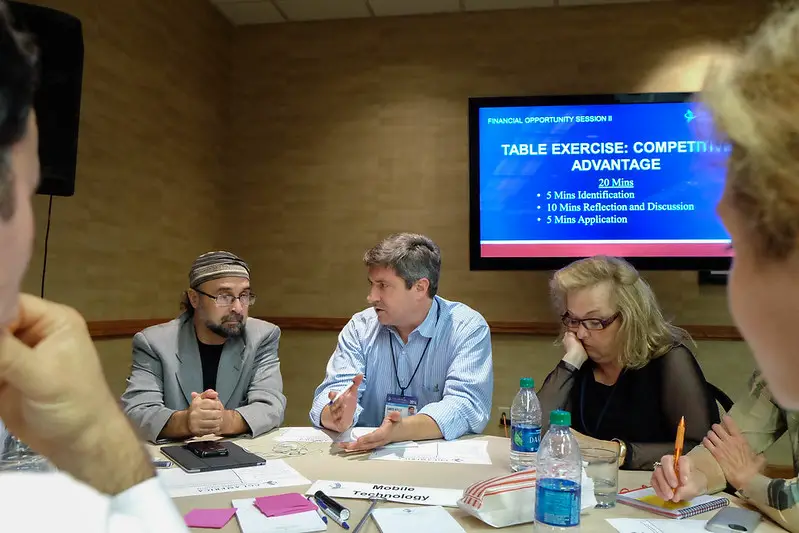As parents, all of us want to provide our children with all advantages in life –particularly when it is about their education. Sadly, our school system isn’t teaching our kids about one of the most basic aspects of life: money. Schools attempt to provide children the tools they’ll require to go out and find a good job. They teach kids how to be a worker and not how to become an entrepreneur.
The majority of the teachers are basically not fortified to give financial education. They come from a world of provable figures and facts. The answer on a test is either correct or it’s wrong. However, in the actual world, things are much more difficult than that. We’re informed to work hard, run from debt, and save money for retirement. However, they do not teach us about the various kinds of income or how to read a financial statement.
It’s left to parents to give the type of financial education that the school systems aren’t set up to deal with. However, first and foremost, you might need to teach yourself on the subject. These book chapters will show the reason why good financial education is really significant and provide you some of the tools you’ll require to start the subject to your own children. It’s a process that ought to start during childhood and carry on into young adulthood.

Chapter 1 – A financial education that is solid adjusts itself to fulfill the needs as well as the experiences of the student.
What’s a great period to teach a kid about finance?
There’s no fixed rule. However, an excellent rule of thumb is when a kid is able to differentiate between a one-dollar bill and a five-dollar bill. When the child can do this, he or she is ready to start their financial education.
This education won’t be a process that requires a period of weeks or months. Financial education requires years, incorporating three different windows of learning, each one with their own part needs.
Quantum Learning is a child’s first window of learning, which occurs from birth until around age twelve. During this period, kids are basically learning machines. They are able to learn without effort. Each new experience teaches them a new thing about life and the world that surrounds them.
During the age of four, the brain starts to separate into different hemispheres: the left – believed to be the more analytical half – and the right, which is the artistic, creative aspect. The majority of the kids will end up preferring either the left or the right hemisphere. Parents can make the most of this change by teaching their children on finance with games such as Monopoly. Games involve both the left and right hemispheres; therefore, regardless of what part your child prefers, their learning centers will be engaged and aroused.

As soon as a child clocks twelve, it gets more difficult to learn basic skills such as languages. The process changes into a stage of Rebellious Learning at this age. The child wants to make decide for themselves and learn what they want to learn. Sadly, they aren’t usually aware of the repercussions of their choices, and this can put them into trouble.
It’s a serious period that can test the relationship of any parent-child; however, you can still teach them effectively. One clue is to make them know any likely repercussions by openly talking about your own financial issues when they arise.
Professional Learning is the third window of learning, which occurs in young adulthood when they’re having their first experience of the actual world. They’ll develop the lessons they learned from childhood and make use of them to their own lives. This is the period when we discover whether or not we’ve selected the right career path. If it isn’t a great fit, now is a great time to change their path.
So, what is the right career? How can you assist your kid to choose the right path? Discover about that in the following chapter.
Chapter 2 – Discovering your place in the Cashflow Quadrant is more significant than picking a certain profession.
Although it’s significant to pick the right career, the certain profession you pick isn’t essentially the most significant choice you’ll have to make. What is more significant is choosing where you wish to work in the Cashflow Quadrant.
Discovering the quadrant that’s appropriate for you isn’t a thing that you learn in school. However, it may be one of the most vital choices you will ever make.
There are four income quadrants and each of them is represented by an alphabet. “E” stands for employees; this is where the majority of the people see themselves. “S” represents small-business, or self-employed. That can imply anybody who works for a commission or fee, such as doctors and lawyers. “B” represents big business – entrepreneurs such as Steve Jobs who found companies that hire hundreds of individuals. Lastly, “I” represents investors, financial geniuses such as Warren Buffett. In this “I” category, passive investors who invest in pensions and 401(k)s aren’t part.
The school system trains children for life in either the “E” or the “S” quadrant. They’re told to study hard to find a good job with a regular paycheck. Sadly, these two quadrants as well bear the heaviest tax burden. It’s the people in the “B” and “I” quadrants who legally pay small or no taxes. Real financial independence can only be accomplished in one of these two quadrants.
One of the issues with the educational system is that it teaches students to be specialists in a specific field. This may assist secure success in the “E” and “S” quadrants –however, attaining the top of the “B” and “I” quadrants need a different set of skills. Successful entrepreneurs, as well as investors, have to be generalists, not specialists.

In school, your grades show how well you’ve learned a particular subject. It’s a world of absolutes: either right or wrong, pass or fail. “A” students have a tendency to become specialists, working in the “E” or “S” quadrants. Students who get “C”s may possess gifts in other aspects that let them understand the bigger picture. Also, that’s the reason why we say that “A” students work for “C” students.
Beginning your career in one quadrant doesn’t imply you need to remain there permanently. It’s likely to change from one to the other, particularly as your Professional Learning curve provides you more understanding of your strengths and weaknesses. Everything relies on your main source of income. In the following chapter, we’ll take a look at the different kinds of income.
Chapter 3 – Teach your kids on the dissimilarity between ordinary, portfolio, and passive type of income.
As we recently mentioned, it is likely to change between cashflow quadrants. How can that be done?
Changing from one quadrant to the other needs changing your main source of income. There are three kinds: ordinary, portfolio, and passive.
The majority of schools just teach students how to work for ordinary income – regular, steady paychecks. Ordinary income is taxed at the highest likely rate, even savings account as well as 401(k) plans. This is another great cause of why it’s significant to educate your children about taxes. It’s a difficult subject for everybody; therefore, the earlier they can start to understand it, the better it is.
Portfolio income, or capital gains, is where the majority of the investors put in their money. This is an increase from ordinary income; however, it still has a bigger tax burden as well as risk. Even a supposed “diversified” stock portfolio is barely really diverse, with individuals making investments in numerous companies in a related field. If an incident occurs that affects one, it will most likely affect all of them.
Passive income is also referred to as cash flow. These are assets, which can very basically be described as anything that brings cash into your pocket. Conversely, liabilities take out money from your pocket. A lot of people still mistakenly label their house as an asset when it’s really a liability. An actual asset is a rental property, like an apartment complex. This gives a regular source of revenue that is taxed at the lowest of every rate. As you might have assumed, passive income is the kind of income that’ll assist you to attain financial independence.

You can make use of games such as Monopoly to educate your children about passive income. When you build houses or hotels on a property in Monopoly, you now get a regular source of revenue. There’s no means to win Monopology without following that approach. If you choose to keep your money and not purchase properties, you’re eventually going to end up losing.
Educating your children about the three kinds of income will offer them a financial advantage in the future. However, you can’t depend on the school system to do that for you. The majority of the teachers work for ordinary income. They’re specialists. These teachers might not even know that there are three kinds of income. Therefore, it’s mandatory for parents to offer their kids this financial education.
Chapter 4 – People that are young feel a sense of control and security over their future with financial education.
Without financial education, a lot of individuals drop out of school financially desperate. If they eventually get a well-paying job, they’ll do whatever they can to keep it. This is the reason why a lot of CEOs are less bothered about the company they work for and more concerned about their own golden parachute retirement packages. This whole thing is a direct outcome of schools failing to fulfill one of our most simple needs: safety.
Psychologist Abraham Maslow developed the Hierarchy of Needs in the year 1943. His theory talks about a pyramid with the most basic physiological needs at the bottom of the hierarchy – things like food and shelter. Just after those needs are met, Maslow recommends, can we proceed to fulfill more advanced needs such as safety, love, esteem, and self-actualization.
Level two of Maslow’s Hierarchy is safety, and it comprised employment, resources, property, and morality. By not giving financial education, schools are not meeting this need in their students, who graduate unsure about their future and desperate to get a job. Also, people that are desperate use desperate approaches.

It’s a popular misunderstanding that people who are rich are greedy. This is buttressed all through the school with texts such as Charles Dickens’s A Christmas Carol that depict people that are rich as villains. As a matter of fact, it is desperation that makes people get greedy. Desperation promotes a sense of entitlement that is antithetical to the real capitalist spirit. Conversely, people that are rich can be very generous.
Therefore, how can parents meet this need for safety with education? When they are set to go into the workforce, rather than persuading your kids to find a part-time job, support them to look for opportunities. This could entail working for a mentor where they get money in the real-world experience rather than a paycheck. Or, getting a job in a fast-food restaurant that lets them work in different capacities – janitor, cook, cashier, or shift manager – and actually study their business approaches. At this stage in their lives, building up a variety of experiences can be more significant than a minimum wage paycheck.
These basic ideas can assist provide people that are young a sense of control over their financial future. We can proceed to total self-actualization only when we feel safe
Chapter 5 – Don’t give money to your children.
As we talked about in the former chapter, desperation can encourage a sense of entitlement in individuals. That sense of entitlement has become a popular thing in our society. We have formed a universe where numerous people think that they deserve something for nothing. That is not a lesson you want to teach your kids. Also, there is one easy thing you can do to assist stop your children from having an entitlement mentality.
Whether they’re rich or poor, some parents have a bad habit of attempting to show how much they love their children with money. They’ll buy luxurious shoes, and toys for their children…eventually cars as well. When this occurs every time, the children grow up thinking the only thing they have to do is to request for something and they’ll get what they ask for. If their best friend gets the latest high-end video game system, they believe they deserve to get that same thing as well.
Our schools aren’t assisting to combat entitlement mentality, either. Nowadays, when children compete in school tournaments, everyone receives a trophy only for participating. What type of lesson does that teach kids? That you’re a winner only for participating?
Kids have to know precisely what money is. It’s a medium of exchange. Meaning. If you do a thing for me, you receive something in return. Also, the more you give, the more you get. The seeds of entitlement are planted when the kid basically gets a handout.

Rather than giving children weekly pocket money, create a system where children are being rewarded for their hard work. The more they go over and above what’s required of them, the more they receive in return. Likewise, this is a good means to talk about the idea of generosity with them. The more generous they get with their time as well as their effort, the more they’ll receive in return– not only in money but in experience and education as well.
The situation against the entitlement mentality is perfectly summarized by the proverb, “Give a man a fish, and you feed him for one day. Teach a man how to fish, and you feed him for a lifetime.” Before you give your child a handout, ask yourself this question: Are you teaching your child how to fish? Or are you teaching them how to request for a fish?
Chapter 6 – Educate your children to understand the dissimilarity between financial advice and financial education.
A lot of frequent financial issues start with the same root cause. Individuals confuse financial advice for financial education. These may seem exactly the same; however, there’s a huge difference. Receiving financial advice signifies that you’re asking a person to tell you how to use your money. Financial education signifies determining what to study in order for you to choose for yourself.
Any time a person attempts to tell you the thing you should do with your money, first ask yourself this question, “What is their gain form it?” A financial advisor might attempt to convince you to spread your stock portfolio. However, they are not actually aware of which stocks will increase and which will decrease. Due to that, they don’t actually care since they’ll receive a commission either way. A banker who persuades you to save your money is angling for you to request for credit cards and home loans. Banks don’t profit from your savings. They make a profit from your debt.
In circumstances such as this, the only thing you are is a customer; stockbrokers and banks are profiting from your financial ignorance. However, financial education lets you have their profit for yourself. The foundation of any good education is studying its language – not just the words alone but the connections between them.

For instance, one of the most fundamental terms in the language of money is “income.” If someone buys an asset, like a rental property, you can simply show how the income increases. By the same token, it’s simple to show how a liability makes the income to reduce.
“Debt” is one of the most misinterpreted terms in the language of money. The majority of us have been told from a tender age that debt is not good, and we should try by all means to run from it. Truly, at times debt is a liability. However, you can as well make use of debt for your own benefit. For instance, if you take a loan from a bank to buy a rental property, the increased cash flow may not just pay back the loan but it will increase your passive income as well. The debt is an asset in this situation.
The secret to real education is the skill to see beyond one viewpoint at the same time. Debt can either be good or bad depending on how it’s utilized. Some might call a millionaire greedy, whereas other people regard him as ambitious. This is the ability we want to transfer to our children. Don’t decide for them how to spend their money. Provide them with the tools they require to make those choices themselves.
Why “A” Students Work for “C” Students and “B” Students Work for the Government: Rich Dad’s Guide to Financial Education for Parents by Robert T. Kiyosaki Book Review
All of us hope for our kids to be wealthier than we were. A good financial education can assist make that become a reality and offer them a big edge in life. However, we can’t depend on other people to give that education. It’s left to us, as parents, to teach our children in the language of money.
Set apart one night per week as Financial Education Night.
You can play games such as Monopoly, talk about your family’s financial circumstance, or create goals for their financial future. Just a small education per week can make a huge difference.
